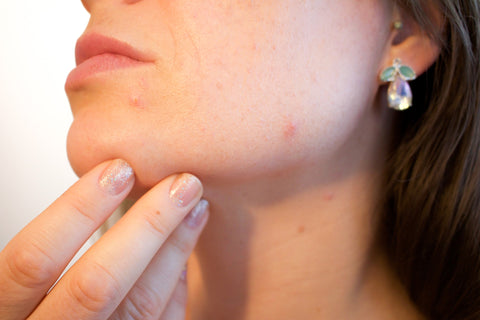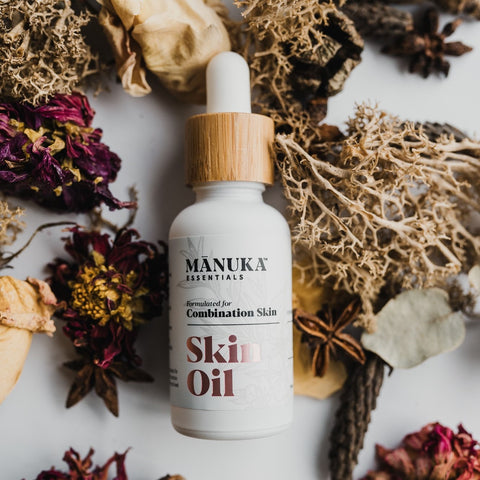The Ultimate Guide to Care For Combination Skin
What is combination skin?
If your skin is dry or oily, your skincare needs may be relatively straight forward. When you have a combination of both however, not so much. And it’s extremely common, says Ranella Hirsch, assistant clinical professor of dermatology at the Boston University School of Medicine.
Oily skin is caused by excess sebum production, your skin’s naturally occurring oil, which can come about for a number of reasons, explored in more depth here. Dry skin is caused by a lack of moisture in the epidermis, which can also be caused by numerous factors which we dive into here.
When you have areas of your face that experience both these states, you might find that moisturizers ease some areas and not others and that oily products both hydrate and exacerbate. How do we achieve the balance?
The key difference with combination skin care is spot treatment. Just as certain areas of your face are behaving differently, you’ll need to apply the right skincare to those spots. Here, we explore bringing our dry and oily skin care approaches together to ensure that you are giving all the areas of your skin what they need.
How to tell if you have combination skin
First up, let’s check out how we can tell if our skin is a combination of dry and oily, and how we know which areas are which. You have a few options for tests:
1. Day test
According to board-certified dermatologist and cosmetic surgeon Melanie Palm MD, the easiest way to determine your skin type is to observe it on a typical day, from AM to PM.
If you suspect combination skin, make sure you look at different areas of your face, too. Typically, your T-zone will be oily and cheeks dry, but this may not always be the case.
Make a note of how your skin looks in the morning and then in the evening. Use this table to identify what these observations might tell you about your skin type:
|
Skin appearance/feel |
Type |
|
Oily/shiny |
|
|
Shiny T-zone but elsewhere more matte |
Combination |
|
Minimal dryness, oiliness or rosacea |
|
|
Skin feeling tight or showing flakiness |
Please note: if your skin is dehydrated, this is different to dry and may need different care.
2. Cleanse test
If you have the kind of routine that won’t work for the above, like you shower during the day, try this simple technique. Wash your face as usual and leave it without makeup, moisturizer or any other products for around an hour. Pick a time when your skin is fairly neutral - i.e, you haven’t recently exercised, been out in cold or hot weather, or done a chemical peel.
Observe how your skin looks and feels to get an idea of what’s happening beneath the surface. Use the table above to determine which areas of your face might be which type.
3. Photo test
Photos are useful and used by dermatologists to pick up on extra information about your skin’s health. These specific photo methods may not be readily accessible at home, but if you are having trouble taking care of your skin or determining which type/s you have, chat to a dermatologist about this option.

Taking care of combination skin
So now you know that you do have combination skin, and which areas require some TLC, let’s get down to the specifics. Aside from our top tips for dry and oily skin, below are some steps you can take to ensure your combined approach works. Your general rule of thumb is: treat areas separately.
- Cleansing: use a gentle cleanser for your entire face in the morning and evening. Then consider using a cleansing brush for your T-zone to gently remove the debris which might clog your oilier pores, once or twice a day.
- Moisturising: it is important to still hydrate and moisturize your skin, you just might need to change up your products slightly. Stick to lighter lotions that work to mattify.
- Using masks: if you like using masks, even with your combination skin you have options. Look for a moisturizing mask, perhaps with honey, for your dry areas and something with clay to absorb oil in your oilier areas.
- Upkeep during the day: blotting papers are useful for those oily T-zones, which are often made worse by hot weather. They are easy to carry around and give you a quick dab and go option!
Perfecting your skincare regime takes time, trial and error, and sometimes professional advice if you need it. Make sure you listen to your skin, take the time to notice it and give products a chance to work their magic!
This will be even more of a dance for combination skin as you will need to try a few combinations of treatments to find your best fit.
The best natural oils for combination skin

Packed full of naturally-occurring vitamins and minerals, we have formulated the ideal oil blend for nourishing your combination skin. Working to balance sebum production whilst keeping your skin hydrated, our Skin Oil for Combination Skin contains:
- Jojoba Oil: the best aide in regulating your natural oil (sebum) production.
- Argan Oil: famous for its moisturizing and anti-ageing properties.
- Black Cumin Seed Oil: full of vitamins and micro-nutrients to feed the skin.
- Evening Primrose Oil: rich in omega 6 making it useful for inflamed or irritated skin.
- Açaí Berry Oil: features omegas 3, 6 and 9 as well as B vitamins, vitamin C and micro-nutrients, all great for cell metabolism and skin elasticity.
- East Cape Mānuka Oil: anti-microbial, anti-fungul, anti-oxidant and so much more, find out why we love it here.
- Ylang Ylang Oil: used to soothe the mind as well as the skin, ylang-ylang has a restorative effect.
- Himalayan Cedarwood Oil: a natural toner and good for balancing oil production.
- Lavender Oil: used for its antiseptic and sedative properties.
